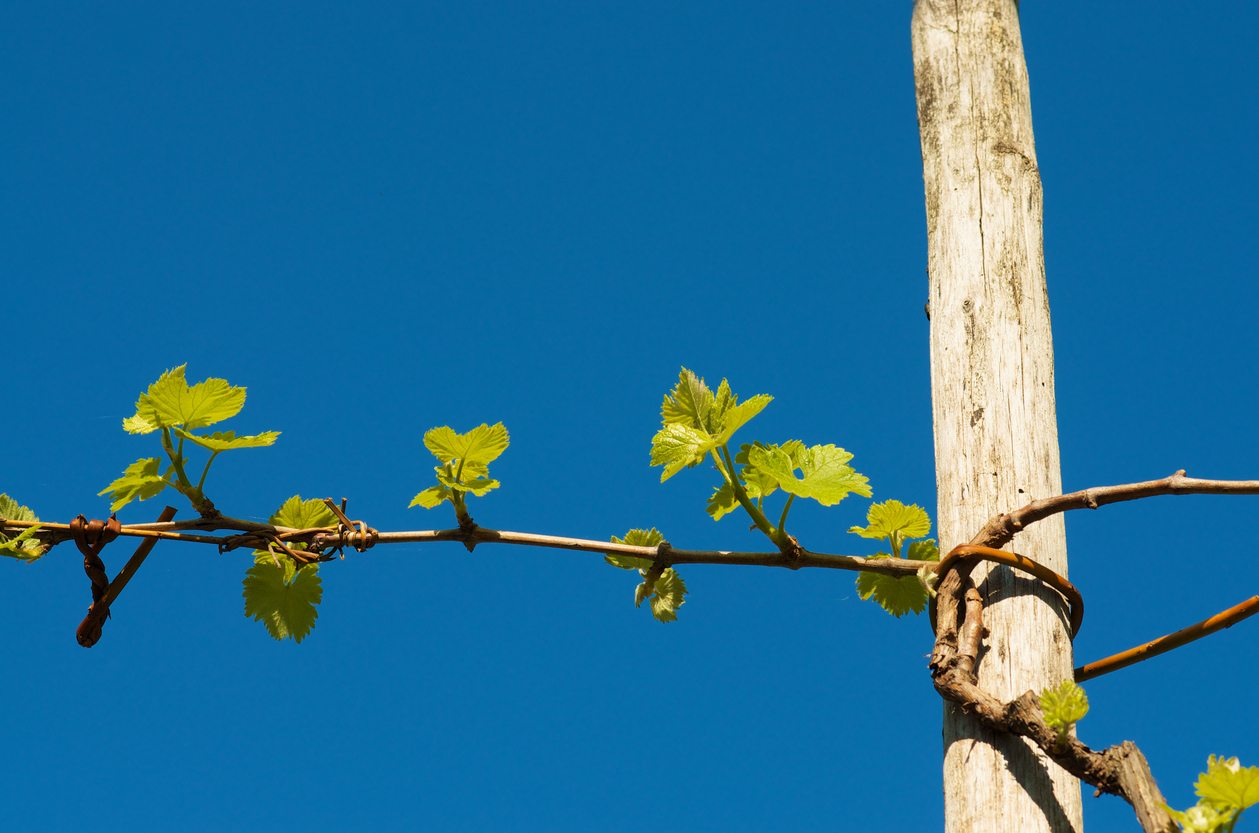Supporting A Grapevine – How To Make A Grapevine Support

Grapes are woody, perennial vines that just naturally like to clamber up things. As the vines mature, they tend to get woody and that means heavy. Of course, grapevines can be allowed to climb up an existing fence to lend them support, but if you don’t have a fence where you want to put the grapevine, another method of supporting the grapevine must be found. There are many types of grapevine support structures-- from simple to complex. The following article discusses ideas on how to make a grapevine support.
Types of Grapevine Support Structures
Support is needed for grapevines to keep the new shoots or canes and fruit off the ground. If the fruit is left in contact with the ground, it will likely rot. Also, support allows a greater area of the vine to gain sunlight and air. There are a number of ways to support a grapevine. Basically, you have two choices: a vertical trellis or a horizontal trellis.
- A vertical trellis uses two wires, one about 3 feet (1 m.) above ground to allow for good air circulation under the vines, and one about 6 feet (2 m.) above ground.
- A horizontal system uses three wires. One wire attaches to the post about 3 feet (1 m.) above ground and is used for trunk support. Two parallel wires are attached horizontally to the ends of 4 foot (1 m.) long cross arms secured to posts 6 feet (2 m.) above ground. These horizontal lines hold the canes in place.
How to Make a Grapevine Support
Most people use a vertical trellis system. This system uses posts that are either wood treated for ground use, PVC, or galvanized steel or aluminum. The post should be 6.5 to 10 feet (2-3 m.) in length, depending on the size of the vine and you will need three of them. You will also need at least 9-gauge galvanized aluminum wire or up to 14-gauge, again depending upon the size of the vine. Pound a pole 6 inches (15 cm.) or so into the ground behind the vine. Leave 2 inches (5 cm.) of space between the pole and the vine. If your poles are more than 3 inches (8 cm.) across, this is where a hole digger comes in handy. Backfill the hole with a mix of soil and fine gravel to solidify the pole. Pound or dig a hole for another post about 6 to 8 feet (2 m.) from the first and backfill as before. Pound or dig a hole between the other two posts for a center post and backfill. Measure 3 feet (1 m.) up the posts and drive two screws halfway into the posts on either side. Add another set of screws near the top of the posts at around 5 feet (1.5 m.). Wrap the galvanized wire around the screws from one post to the other at both the 3 foot (1 m.) and 5 foot mark (1.5 m.). Tie the vine to the center post with landscape ties or twine at 12 inches (31 cm.) high. Continue to tie the vine every 12 inches (31 cm.) as it grows. As the vine matures, it thickens and the ties can cut into the trunk, causing damage. Keep a close eye on the ties and remove those that become too tight and re-secure with a new tie. Train the vines to grow along the top and middle wire between the posts, continuing to tie them every 12 inches (31 cm.). Another idea for supporting a grapevine is by using pipes. The author of the post I read recommends using Klee Klamp fittings. The idea is much the same as above only using pipe fittings instead of posts and galvanized wire. Even a combination of materials will work as long as everything is weatherproof and sturdy and assembled properly. Remember, you want to have your vine for a long time, so take the time to make a strong structure for it to grow on.
Gardening tips, videos, info and more delivered right to your inbox!
Sign up for the Gardening Know How newsletter today and receive a free copy of our e-book "How to Grow Delicious Tomatoes".

Amy Grant has been gardening for 30 years and writing for 15. A professional chef and caterer, Amy's area of expertise is culinary gardening.
-
 4 Superfast Composting Methods: Turn Waste Into Garden Gold In 30 Days Or Less
4 Superfast Composting Methods: Turn Waste Into Garden Gold In 30 Days Or LessTry the fastest composting methods to turbocharge your pile and transform kitchen scraps and garden waste into finished compost in just a few weeks.
By Mary Ellen Ellis
-
 Best Spider Plant Soil – Complete Soil Guide And Expert Tips For Keeping Plants Happy
Best Spider Plant Soil – Complete Soil Guide And Expert Tips For Keeping Plants HappySpider plants are fun and easy plants to grow, but what is the best soil for a spider plant? Selecting the right soil is important so they can thrive.
By Bonnie L. Grant